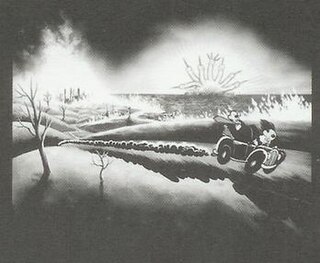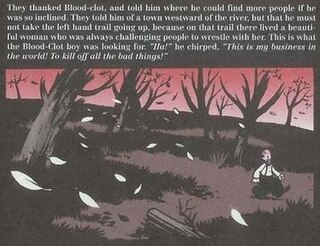
Jacob Kurtzberg, best known by the pen name Jack Kirby, was an American comic book artist, writer and editor, widely regarded as one of the medium's major innovators and one of its most prolific and influential creators. He grew up in New York City and learned to draw cartoon figures by tracing characters from comic strips and editorial cartoons. He entered the nascent comics industry in the 1930s, drawing various comics features under different pen names, including Jack Curtiss, before ultimately settling on Jack Kirby. In 1940, he and writer-editor Joe Simon created the highly successful superhero character Captain America for Timely Comics, predecessor of Marvel Comics. During the 1940s, Kirby regularly teamed with Simon, creating numerous characters for that company and for National Comics Publications, later to become DC Comics.
Fleischer Studios was an American animation studio located at 1600 Broadway, New York City, New York. It was founded in 1921 as Inkwell Studios, Inc. and Out of the Inkwell Films by brothers Max Fleischer and Dave Fleischer who ran the pioneering company from its inception until Paramount Pictures, the studio's parent company and the distributor of its films, acquired ownership. In its prime, Fleischer Studios was a premier producer of animated cartoons for theaters, with Walt Disney Productions becoming its chief competitor in the 1930s.

Famous Studios was the first animation division of the film studio Paramount Pictures from 1942 to 1967. Famous was founded as a successor company to Fleischer Studios, after Paramount seized control of the aforementioned studio and ousted its founders, Max and Dave Fleischer, in 1942. The studio's productions included three series started by the Fleischers—Popeye the Sailor, Superman, and Screen Songs—as well as Little Audrey, Little Lulu, Casper the Friendly Ghost, Honey Halfwitch, Herman and Katnip, Baby Huey, and the anthology Noveltoons series.
Al Columbia is an American artist best known for his horror-themed alternative comics and illustrations. Comics writer Heidi MacDonald has described him as a "cartoonist’s [cartoonist] whose body of work is as unforgettable as it is slim." His noted publications include the comic book series The Biologic Show, the art book Pim & Francie: The Golden Bear Days, and short stories including "I Was Killing When Killing Wasn't Cool" and "The Trumpets They Play!". Other media in which he has worked include painting, printmaking, music, video, and set design.

Jack of Hearts is a fictional superhero appearing in American comic books published by Marvel Comics. The character first appeared in Deadly Hands of Kung Fu #22, and was created by writer Bill Mantlo and artist Keith Giffen. He starred in his own four-issue mini series and has been a regular character in the Iron Man comics as well as at one point being a regular in the Avengers comic book.
"Alias the Spider" is a comic-book superhero feature from the Golden Age of Comic Books that appeared in Quality Comics' Crack Comics for nearly three years, starting with issue #1 in 1940. He was created by writer-artist Paul Gustavson.

Deacon Frost is a fictional character appearing in American comic books published by Marvel Comics. He appears in The Tomb of Dracula, and is an enemy of Blade. In the comics, Deacon Frost was depicted as a tall, white-haired, late middle-aged gentleman with red eyes, and wearing 1860s Germany period clothing. His doppelgänger sported an accent and attire that suggested a Southern preacher.
Jack O'Lantern is an alias used by several fictional supervillains appearing in American comic books published by Marvel Comics.

Big Numbers is an unfinished graphic novel by writer Alan Moore and artist Bill Sienkiewicz. In 1990 Moore's short-lived imprint Mad Love published two of the planned twelve issues. The series was picked up by Kevin Eastman's Tundra Publishing, but the completed third issue did not print, and the remaining issues, whose artwork was to be handled by Sienkiewicz's assistant Al Columbia, were never finished.
Joseph Oriolo was an American cartoon animator, writer, director and producer, known as the co-creator of Casper the Friendly Ghost and the creator of the Felix the Cat TV series.

Half-Wits Holiday is a 1947 short subject directed by Jules White starring American slapstick comedy team The Three Stooges. It is the 97th entry in the series released by Columbia Pictures starring the comedians, who released 190 shorts for the studio between 1934 and 1959.
The Popeye Song Folio is a collection of 24 songs issued by Popular Melodies, Inc. 1619 Broadway, New York City in 1936. They contain the tunes played in the various Popeye cartoon short series directed by Dave Fleischer.

The Biologic Show is a comic book series written and drawn by Al Columbia. The first issue, #0, was released in October 1994 by Fantagraphics Books, and a second issue, #1, was released the following January. A third issue (#2) was announced in the pages of other Fantagraphics publications and solicited in Previews but was never published. "I Was Killing When Killing Wasn't Cool", a color short story with a markedly different art style originally intended for issue #2, appeared instead in the anthology Zero Zero. In a 2010 interview, Columbia recalled that the unfinished issue "looked so different that it just didn’t look right, it didn’t look consistent, and it didn’t feel right to keep putting out that same comic book, to try to tell a story where the style is mutating." The series' title is taken from a passage in the William S. Burroughs book Exterminator!. The passage in question is quoted briefly in a story from issue #0, itself also titled "The Biologic Show".

"The Trumpets They Play!" is an 8-page comic by Al Columbia. A cartoon interpretation of the Book of Revelation featuring his recurring characters Seymour Sunshine and Knishkebibble the Monkey-Boy, it was published in BLAB! #10 in 1998.

"Amnesia" is an 8-page comic by Al Columbia. It was published in the twentieth issue of Zero Zero. Columbia originally created the artwork for a slideshow in a Tales from the Crypt CD-ROM video game being developed by Inscape but turned it into a comic when the game was cancelled.

"The Blood-Clot Boy" is a 6-page comic by Al Columbia. It was published in the sixteenth issue of Zero Zero.

Popeye the Sailor is an American animated series of comedy short films based on the titular comic strip character created by E. C. Segar. In 1933, Max and Dave Fleischer's Fleischer Studios adapted Segar's characters into a series of Popeye the Sailor theatrical cartoon shorts for Paramount Pictures. The plotlines in the animated cartoons tended to be simpler than those presented in the comic strips, and the characters slightly different. A villain, usually Bluto, makes a move on Popeye's "sweetie," Olive Oyl. The villain clobbers Popeye until he eats spinach, giving him superhuman strength. Thus empowered, Popeye the sailor makes short work of the villain.

"Part 2", also known as "The Return, Part 2", is the second episode of the third season of the TV series Twin Peaks. It was written by Mark Frost and David Lynch, directed by Lynch, and stars Kyle MacLachlan. "Part 2" was broadcast on Showtime along with Part 1 on May 21, 2017, and seen by an audience of 506,000 viewers in the United States. In addition, the two episodes were shown as a feature at the 2017 Cannes Film Festival, where they received a standing ovation. The episode received critical acclaim.

Absolute Carnage is a 2019 comic book crossover published by Marvel Comics, by Donny Cates and Ryan Stegman.
Amnesia: The Lost Films of Francis D. Longfellow Supplementary Newsletter No. 1 is a 2018 comic book by Al Columbia. It is a 24-page collection of promotional posters allegedly created for animated cartoons by the (fictional) titular director/producer and his company, Podsnap Studios. Some of the "lost films" feature Columbia's recurring characters Seymour Sunshine and Knishkebibble the Monkey-Boy, which are depicted here as cartoon characters performed by voice actors. The posters also contain references to earlier Columbia works including "The Trumpets They Play!", "I Was Killing When Killing Wasn't Cool", and his 1997 "Amnesia" short story, suggesting continuity with Amnesia's fictional universe.














